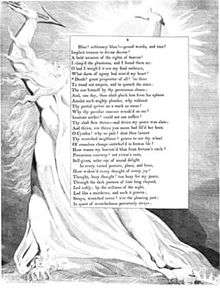Night-Thoughts
The Complaint: or, Night-Thoughts on Life, Death, & Immortality, better known simply as Night-Thoughts, is a long poem by Edward Young published in nine parts (or "nights") between 1742 and 1745.


The poem is written in blank verse. It describes the poet's musings on death over a series of nine "nights" in which he ponders the loss of his wife and friends, and laments human frailties. The best-known line in the poem (at the end of "Night I") is the adage "procrastination is the thief of time", which is part of a passage in which the poet discusses how quickly life and opportunities can slip away.
Night-Thoughts had a very high reputation for many years after its publication, but is now best known for a major series of illustrations by William Blake in 1797. A lesser-known set of illustrations was created by Thomas Stothard in 1799.
The nine nights are each a poem of their own. They are: "Life, Death, and Immortality" (dedicated to Arthur Onslow); "Time, Death, Friendship" (dedicated to Spencer Compton); "Narcissa" (dedicated to Margaret Bentinck); "The Christian Triumph" (dedicated to Philip Yorke); "The Relapse" (dedicated to George Lee); "The Infidel Reclaim'd" (in two parts, "Glories and Riches" and "The Nature, Proof, and Importance of Immortality"; dedicated to Henry Pelham); "Virtue's Apology; or, The Man of the World Answered" (with no dedication); and "The Consolation" (dedicated to Thomas Pelham-Holles).
In his 1791 book, Life of Samuel Johnson, James Boswell called Night-Thoughts "the grandest and richest poetry that human genius has ever produced".
Blake's illustrations of 1795–1797
William Blake was commissioned in 1795 to illustrate Night-Thoughts for a major new edition of the poem to be published by Richard Edwards. Blake began by making a series of 537 watercolour illustrations from which he planned to engrave about 200 for publication. The first volume – with forty-three engravings by Blake – was published in 1797, but it was a commercial failure and the expensive publishing venture was abandoned.
Because the principal evidence of Blake's work on these illustrations was the comparatively short series of engravings, art history has been slow to recognise the significance of the project within Blake's œuvre. In 1980, the Oxford University Press began publication of a projected five-volume scholarly edition of Blake's version of Night-Thoughts, edited by J. E. Grant et al.; two volumes have so far appeared and the fifth has apparently been abandoned.[1] In 2005, the Folio Society published in two volumes a fine edition facsimile accompanied by a commentary by Robyn Hamlyn. The Folio Society facsimile was the first (and thus far only) time that all 537 of Blake's illustrations have been published together in full colour.[2]
See also
- Träd fram du Nattens Gud, a poem by Carl Michael Bellman, inspired by Night-Thoughts
External links
- Night Thoughts complete text and bibliography at 18th Century Poetry Archive
| Wikisource has original text related to this article: |